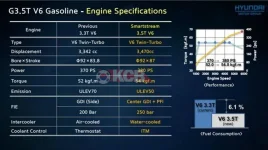soundman414
Registered Member
- Joined
- Dec 13, 2018
- Messages
- 44
- Reaction score
- 36
- Points
- 18
- Location
- Chicago, IL
- Genesis Model Type
- Genesis G70
Interesting bit of info with the recent PR stunt Hyundai Australia did by extensively modifying one of their conversion vans with... you guessed it, a 3.5L Twin Turbo V6.
The article states "Mechanics sent the iMax's 2.5-liter turbodiesel four-cylinder back to the parts bin and replaced it with a 3.5-liter V6 twin-turbocharged engine to make 402 horsepower and 409 pound-feet of torque.". So does that mean the next gen G70 will make over 400hp and 400 ft/lbs of torque? Doesn't seem to crazy.
Anyways, here is a link to the article and video:
2019 Hyundai iMax N drift van unveiled with 402 hp
The article states "Mechanics sent the iMax's 2.5-liter turbodiesel four-cylinder back to the parts bin and replaced it with a 3.5-liter V6 twin-turbocharged engine to make 402 horsepower and 409 pound-feet of torque.". So does that mean the next gen G70 will make over 400hp and 400 ft/lbs of torque? Doesn't seem to crazy.
Anyways, here is a link to the article and video:
2019 Hyundai iMax N drift van unveiled with 402 hp












